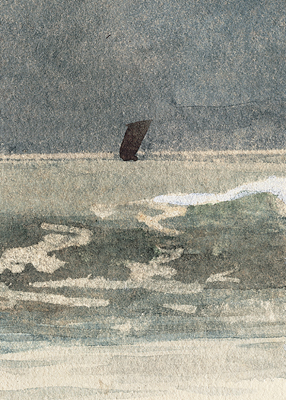Detail: Rewetting and scraping
To create The Watcher, Tynemouth, Homer first painted the ocean in broad green and blue washes mixed with red. Once these were dry, he applied brushstrokes of clean water to suggest the foam swirling in the rising wave at center. After waiting several seconds, he scraped away the softened paint and surface fiber to define the crashing waves at both ends of the composition, adding opaque white watercolor around the scraped areas to indicate the thickest foam. The artist could have used conventional tools such as a sharp knife or scraper, or a duller implement like the end of a brush or palette knife. These allowed him to remove watercolor in precisely defined shapes, controlling the process simply by varying the pressure of his hand. Scraped passages are easily recognized when viewed at an angle; the broken and disrupted paper fibers in these areas have a softer look than the uninterrupted surface.
Detail of The Watcher, Tynemouth, showing where Homer rewet and then scraped away color in precise shapes in order to suggest swirling foam.

